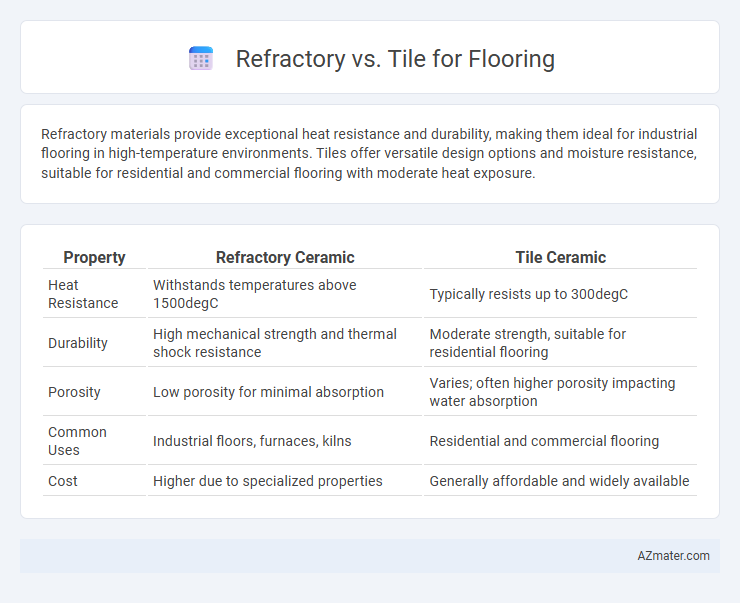Refractory materials provide exceptional heat resistance and durability, making them ideal for industrial flooring in high-temperature environments. Tiles offer versatile design options and moisture resistance, suitable for residential and commercial flooring with moderate heat exposure.
Table of Comparison
| Property | Refractory Ceramic | Tile Ceramic |
|---|---|---|
| Heat Resistance | Withstands temperatures above 1500degC | Typically resists up to 300degC |
| Durability | High mechanical strength and thermal shock resistance | Moderate strength, suitable for residential flooring |
| Porosity | Low porosity for minimal absorption | Varies; often higher porosity impacting water absorption |
| Common Uses | Industrial floors, furnaces, kilns | Residential and commercial flooring |
| Cost | Higher due to specialized properties | Generally affordable and widely available |
Introduction to Flooring Materials
Refractory materials are specialized flooring components designed to withstand extreme heat, commonly used in industrial settings such as kilns and furnaces. Tiles, made from ceramic, porcelain, or natural stone, offer versatile aesthetic and functional solutions for residential and commercial floors with varying durability and maintenance requirements. Understanding the thermal resistance and mechanical strength of these materials is crucial when selecting flooring for applications involving high temperature or heavy foot traffic.
What is Refractory Flooring?
Refractory flooring consists of materials specifically designed to withstand extremely high temperatures, making it ideal for industrial settings such as furnaces, kilns, and steel plants. These floors are engineered with fire-resistant bricks or castables composed of alumina, silica, or fireclay, providing superior thermal insulation and durability under intense heat. Unlike typical tile flooring, refractory floors maintain structural integrity under thermal stress, making them essential for heat-intensive applications.
What is Tile Flooring?
Tile flooring consists of durable, flat pieces made from materials such as ceramic, porcelain, or natural stone, designed for both aesthetic appeal and functionality. It offers water resistance, easy maintenance, and versatility in design, making it suitable for kitchens, bathrooms, and high-traffic areas. Tiles are available in various sizes, shapes, and finishes, providing customizable options for residential and commercial flooring applications.
Key Differences Between Refractory and Tile Flooring
Refractory flooring is designed to withstand extremely high temperatures, making it ideal for industrial environments such as furnaces and kilns, whereas tile flooring is primarily used for residential and commercial spaces due to its aesthetic versatility and moderate durability. Refractory materials typically consist of fire-resistant bricks or castables that endure thermal shock, while tile flooring includes ceramic, porcelain, or natural stone options that offer ease of cleaning and a wide range of design choices. The primary difference lies in their heat resistance and application scope--refractory floors excel in heat-intensive settings, while tile floors prioritize appearance and everyday functionality.
Durability: Refractory vs Tile Flooring
Refractory flooring offers superior durability with high resistance to extreme temperatures, chemical corrosion, and mechanical wear, making it ideal for industrial environments. Tile flooring, while durable for residential or commercial spaces, is more susceptible to cracking and wear under heavy impact or thermal stress. Choosing refractory materials ensures longer-lasting performance in harsh conditions, whereas tile flooring suits moderate-use areas with aesthetic considerations.
Heat and Chemical Resistance Comparison
Refractory materials excel in heat resistance, withstanding temperatures above 3000degF, making them ideal for industrial applications involving extreme heat exposure. Tiles, while more suitable for residential flooring, typically resist temperatures only up to 1200degF and may degrade under prolonged chemical exposure. Chemical resistance favors refractory materials, as their composition resists corrosive substances and thermal shock better than standard ceramic or porcelain tiles.
Aesthetics and Design Options
Refractory materials offer a rugged, industrial aesthetic ideal for high-heat or heavy-use areas, while tile provides versatile design options with a broad range of colors, patterns, and textures suitable for various interior styles. Tiles can mimic natural materials like wood or stone, enhancing aesthetic appeal and allowing for intricate layouts that suit modern and traditional designs. The choice between refractory and tile flooring significantly impacts the visual atmosphere, with tiles generally offering greater flexibility for customization and interior decoration.
Installation Process: Refractory vs Tile
Refractory flooring requires specialized installation involving high-temperature mortars and heat-resistant materials to withstand extreme conditions, often used in industrial settings like furnaces or kilns. Tile flooring installation involves laying ceramic, porcelain, or natural stone tiles over a leveled substrate using thin-set mortar, followed by grouting to ensure durability and aesthetic appeal in residential or commercial spaces. The refractory installation demands expert knowledge of thermal expansion and contraction, while tile installation focuses on precise alignment and moisture-resistant sealing.
Cost Analysis and Long-Term Value
Refractory flooring materials typically offer higher initial costs due to their superior heat resistance and durability, making them ideal for industrial or high-temperature environments. Tile flooring, while generally more affordable upfront, varies widely in price depending on material type, with ceramic and porcelain providing cost-effective options suitable for residential and commercial spaces. Long-term value favors refractory flooring in demanding settings due to its longevity and minimal maintenance, whereas tile may require more frequent replacement or repairs, impacting overall lifecycle costs.
Choosing the Best Flooring: Refractory or Tile?
Choosing between refractory and tile flooring depends on the specific application and environmental conditions; refractory flooring excels in high-temperature resistance and durability, making it ideal for industrial settings or areas exposed to intense heat, while tile flooring offers versatility, aesthetic appeal, and easy maintenance suitable for residential and commercial interiors. Refractory materials typically provide superior thermal shock resistance and chemical stability compared to standard ceramic or porcelain tiles, which may crack under extreme thermal stress. Evaluating factors such as heat exposure, mechanical wear, installation cost, and design preferences ensures the best flooring choice tailored to performance requirements and budget constraints.

Infographic: Refractory vs Tile for Flooring
 azmater.com
azmater.com